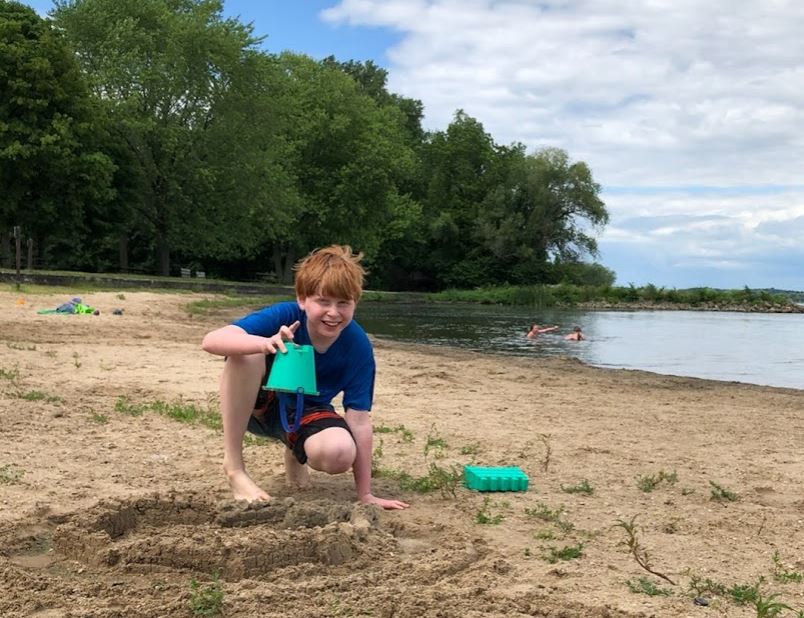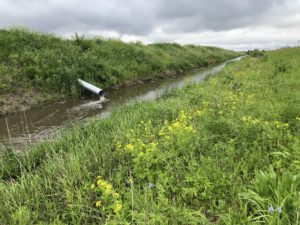Current Stream Conditions in Story County (updated Feb 8)
There’s not much to say in the winter, so excuse us if there are long gaps between updates! The sensors may be removed, nobody can go swimming, and the E. coli standard does not apply. We will post monthly lab results here. Story County is no longer in drought thanks to precipitation in December and January.
Water levels in rivers
To avoid dragging your canoe when paddling the South Skunk River, you’ll need at least 90-110 cfs at the USGS gage north of Ames. The USGS can’t make accurate flow measurements when there’s ice near the sensor, but in that case you can’t paddle anyway!
At 1600 cfs, you need whitewater gear, as shown below On April 23, the South Skunk rose 3 feet following a 2 inch rain, but a few adventurous kayakers were braving the rapids.
The Skunk River Paddlers had a leisurely trip from Ames to Cambridge on April 2nd, when the gage at S. 16th St measured 350 cfs.
Volunteers cleaned up trash in Ioway Creek while paddling on May 21, when the gage at Lincoln Way was around 140 cfs.
Fecal bacteria
E. coli bacteria is an indicator of fecal contamination. Not everyone who goes swimming or boating will swallow water, and not everyone who swallows water will get sick if there is human or animal waste in the water, but when E. coli is high, there is a greater risk.
… in Rivers
Rivers and streams in central Iowa frequently have E. coli levels above the primary contact recreation standard (235 colonies per 100mL), which applies from March 15 to November 15. When enjoying paddling or fishing take some extra precautions to avoid accidentally getting river water in your mouth or on food. We monitor 15 streams in Story County monthly for nutrients and fecal bacteria. When we sampled on November 16, 5/12 samples met the primary contact recreation standard. A diferent criterion (a geomean of 126 colonies/100 mL) is used to evaluate an entire season. Of the 10 sites with sufficient data to evaluate, 9 exceeded the primary contact recreation standard.
Avoid going in the water during and immediately after rain–we measured E. coli levels exceeding the secondary contact recreation standard (2,880 colonies per 100 mL) at all sites after flash flooding in June.
… in Lakes
Iowa DNR and local partners monitor public swimming beaches on weekly basis from Memorial Day to Labor Day, with results posted here. In general, old gravel pits that get most of their water from groundwater (Peterson Park, Ada Hayden Lake) have lower E. coli levels than lakes affected by streams and surface runoff.
The beach monitoring season has ended. A summary will be provided once data is available.
Nitrate
Nitrate (a form of nitrogen) is a concern for the dead zone in the Gulf of Mexico. Prairie Rivers of Iowa and our partners have worked to promote practices in the Ioway Creek watershed that would reduce nitrogen and phosphorus loss. Before commercial fertilizers were introduced, nitrate levels in Iowa streams would have been less than 3 mg/L. While not relevant here, 10 mg/L is the drinking water standard.
Real-time data from nitrate sensors installed by University of Iowa, USGS, and USDA can be found on the Iowa Water Quality Information System.
Nitrate in Ioway Creek exceeded 10 mg/L for much of the spring and summer, but dropped to low levels in late July. During dry, warm conditions, little nitrate is transported to streams and denitrifying bacteria in the stream are more active.
Current nitrate levels in Walnut Creek, near Kelley. This site is influenced by several nearby drainage tiles, which provide a pathway for nitrogen to escape from crop fields.
Farmers near Kelley, take note. Walnut Creek had unusually high nitrate levels (around 20 mg/L) for the entire month of May. By my estimate, that means that farmers in that watershed lost at least 15.6 pounds of nitrogen per acre down the creek that month, which would cost $11 per acre to replace. Cover crops could keep some of this nitrogen in the field.




